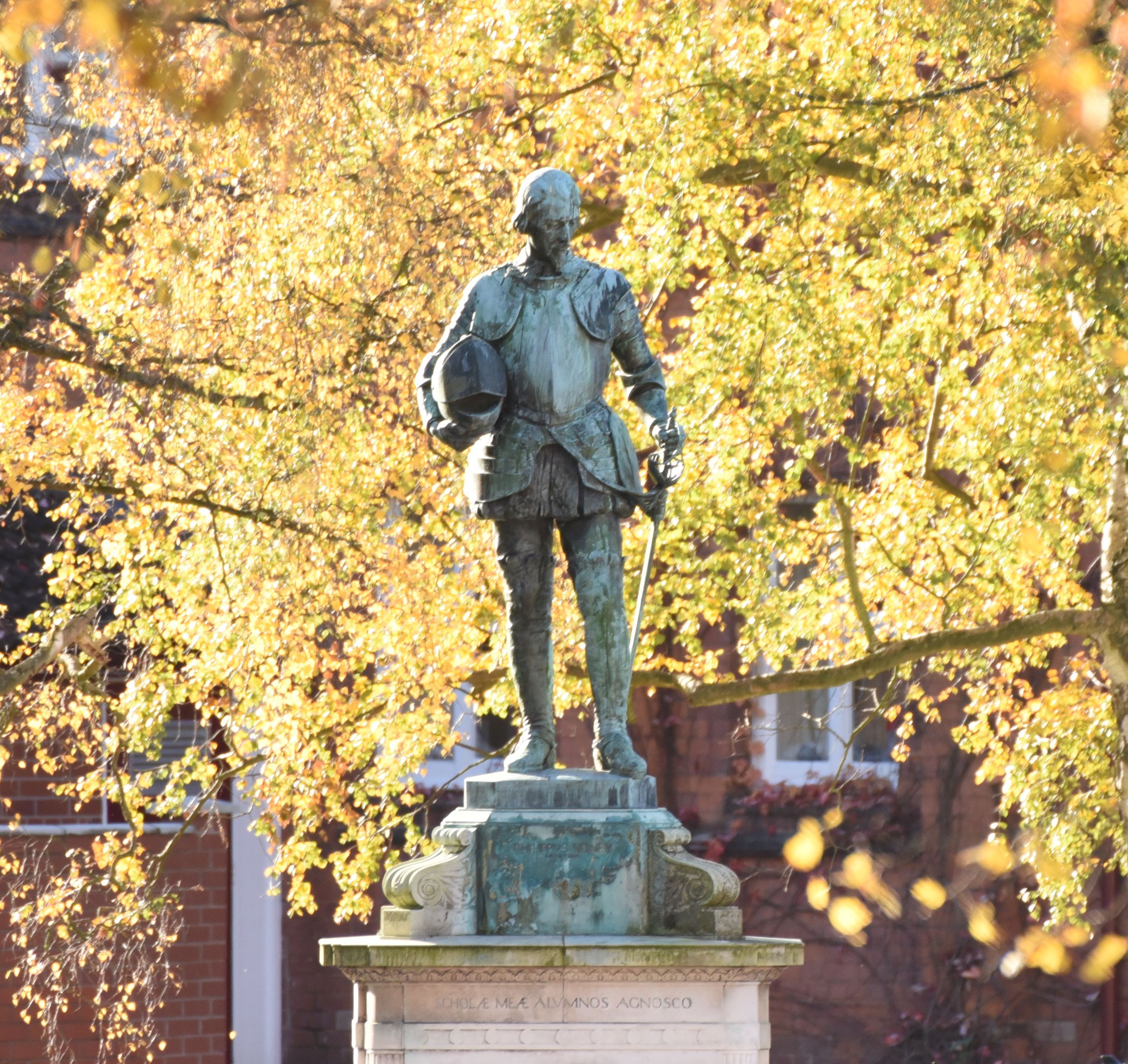
Sir Philip Sidney OS (1554-1586)

"Thy need is yet greater than mine"
Sir Philip Sidney
This is an abridged version of a longer article written by Michael Schützer-Weissmann, former Head of English at Shrewsbury School.
Thirty-one years old at his death in 1586, Sir Philip Sidney was described as “the flower of England”, a man whose fame was such that three European cities competed for the honour of his burial. That Sidney was admired and loved throughout Europe by friends and enemies alike cannot be doubted, but the scale of his fame and the brightness of his star surpass the range and magnitude of his achievements. Sidney is renowned less for what he did and more for what he meant.
As far as Shrewsbury School goes, Sidney meant “the finest example of a soldier and a Christian”, to quote the School’s biographer, Basil Oldham, from his account of the School’s war memorial, the noble statue of Sidney which stands just inside the Moss Gates.

Photo: Sidney statue
The iconography of this monument is worth attention. Dressed in armour, Sidney nevertheless stands in thoughtful repose (never the soldier without being also the scholar). His helmet is off, but so are his cuisses (thigh armour): A.G. Walker, the sculptor, evidently knew the story well. It was precisely because Sidney took off his cuisses, in honour bound, as he believed, to be no better armed than his companion at arms, Sir William Pelham, that he received his fatal wound at the battle of Zutphen.
Beneath the Renaissance figure leaning on his sword, a plaque shows a scene from the trenches, above which are the words: “scholae meae alumnos agnosco”. On the other side is a plaque representing the famous scene at Zutphen when the wounded Sidney gave up his cup of water to a dying soldier with the words ‘Thy need is yet greater than mine'.
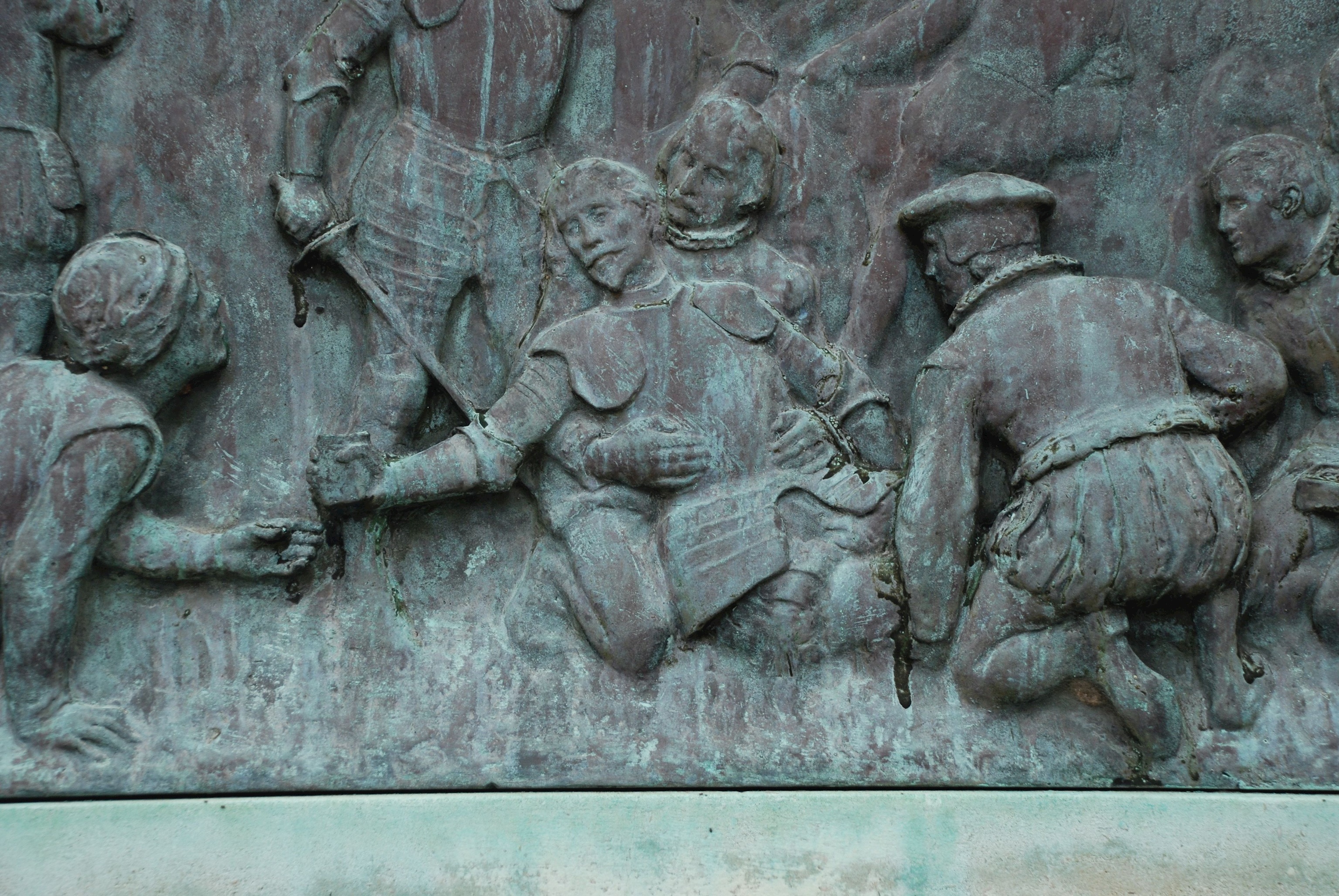
Photo: scene on Sidney war memorial
Sir Philip Sidney’s father, Sir Henry Sidney, to whom Henry VIII had stood as godfather, had been educated alongside the young Edward VI. His mother, Lady Mary Dudley, was the daughter of the duke of Northumberland and the sister of Sir Robert Dudley, who became the Earl of Leicester and Queen Elizabeth I’s most trusted adviser.
Young aristocrats of the 16th century were not usually sent away to school. Sir Henry sent the ten-year-old Philip to Shrewsbury, partly to identify himself with those he governed and served (Sir Henry Sidney, later to become Governor of Ireland, was in 1564 Lord President of the Council in the Marches of Wales) and partly because its headmaster, Thomas Ashton, was a sound Protestant – unlike Shakespeare’s schoolmasters, 50 miles away and ten years in the future, who were zealous Catholics.
We know quite a lot about Philip’s life as a schoolboy. Salopians then did not live in the luxurious style they enjoy now. The main school building in 1564 were not the fine edifice that now houses the town library. It was a low timber building in Ratonyslane (Rotten Row or Rats’ Alley), next to the town gaol. It had no dormitories or privies. But there were similarities between past and present at Shrewsbury School. Then as now, the Sports Fasti was full and varied: “the scholars’ play shall be shooting at the long bow and chess play, and no other games except it be running, wrestling or leaping”. Then as now, pupils liked to go down town: “no … boys … should that night go abroad to disquiet the town with unreasonable noise, fightings and disorders.”
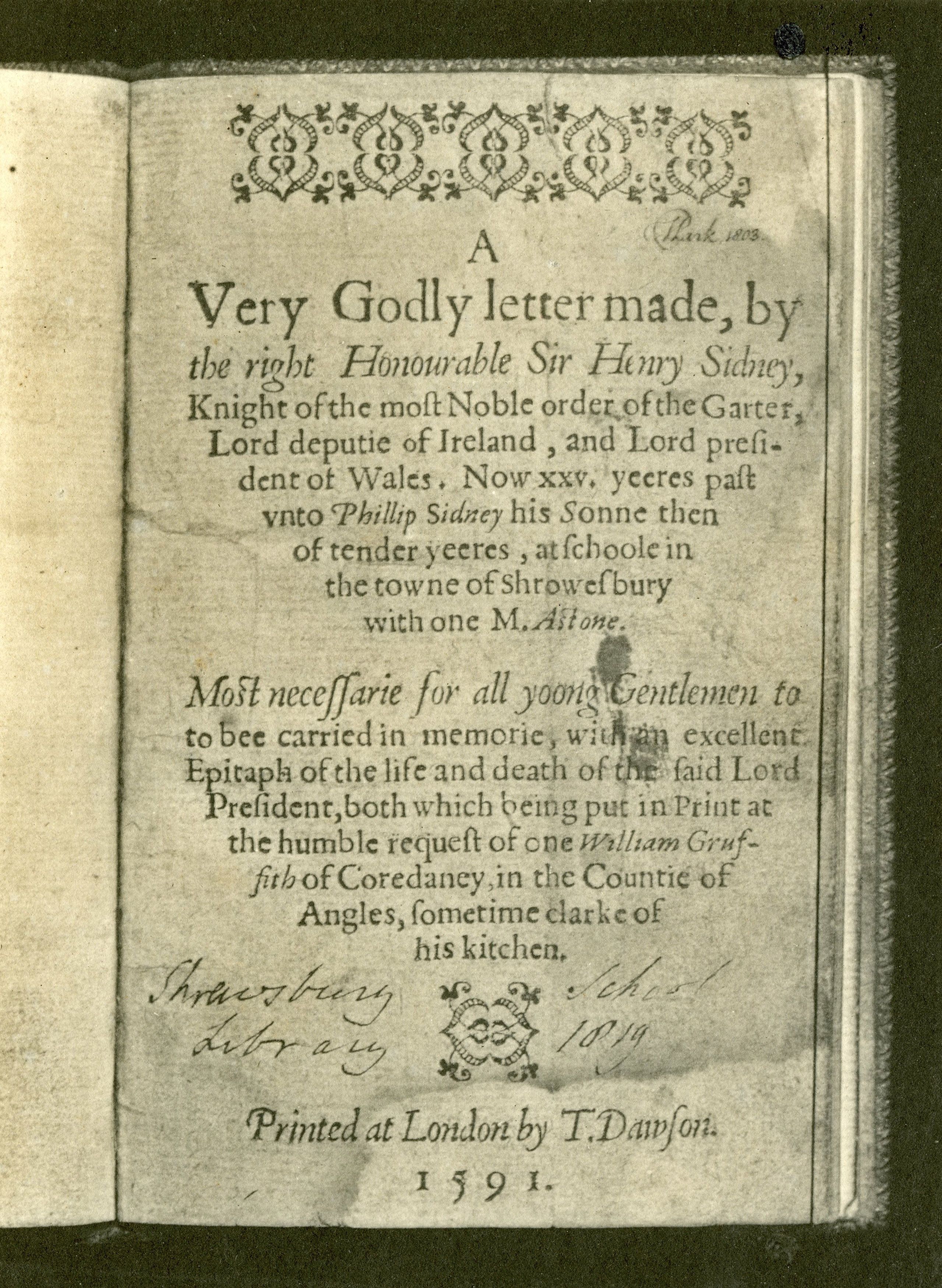
Photo: ‘A very godly letter’
Caption: A letter from Sir Henry Sidney to his young son, written on his entering Shrewsbury School in 1564. With its loving words of advice and hope, it still resonates with parents of children embarking on new adventures at a new school more than 450 years later. Copies of the letter are presented each year to new pupils and their parents at the New Pupils’ Service.
Then as now, the students loved their books and learning, though I fancy few present students can live up to Fulke Greville’s picture of his young schoolmate:
Though I lived with him and knew him from a child, yet I never knew him other than a man: with such staidenesse of mind, lovely and familiar gravity, as carried grace and reverence above greater years. His talk ever of knowledge, and his very play tending to enrich his mind; so as even his teachers found something in him to observe and learn above that which they had usually read or taught.
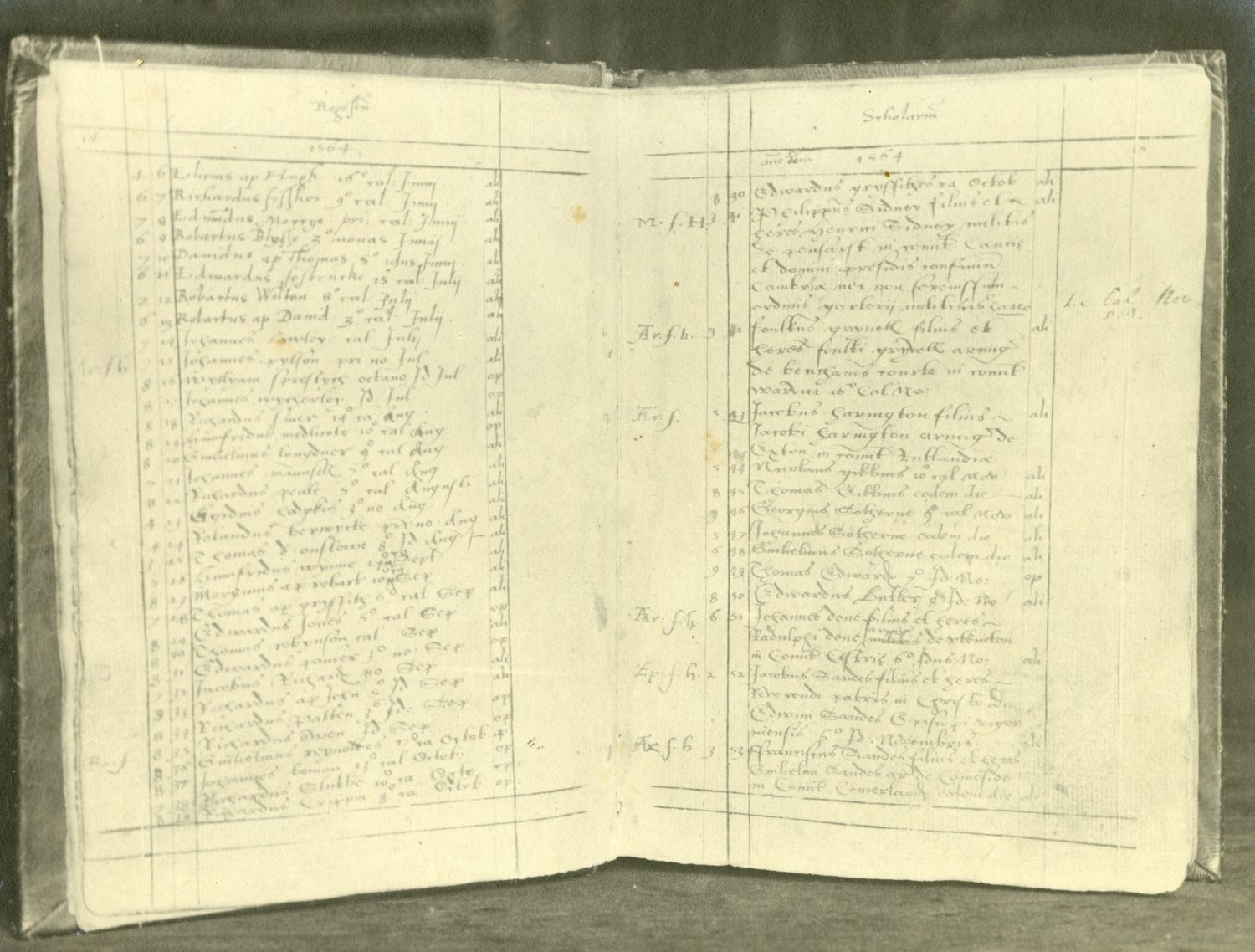
Photo: School Register from 1564 with the names of Philip Sidney and Fulke Greville
After Shrewsbury, Sidney went up to Oxford, but his university career was cut short by an outbreak of the plague in 1571. Thereafter, Sidney’s education was conducted abroad and among men as much as among books. Aged 17, Sidney was given the Queen’s passport to leave England and visit Europe, “for his attaining to the knowledge of foreign languages”, without, however, permission to mix with any Englishmen, “that is departed out of our realm without our licence” - that is, Catholics.
Although Sidney’s European trip had a diplomatic element to it – he was making weight in a team assembled to ratify the Treaty of Blois – its principal purpose was educational: a gap year or two between student life and the real world. Sidney’s world became about as real as it gets on the morning of 24th August 1572. Around dawn on that Sunday began the St Bartholomew’s Day massacres in which 2000 or more Protestants were murdered in Paris alone.
Sidney’s diplomatic status would not have impressed the mob, and he probably owed his life to sanctuary within the compound occupied by the English ambassador, Sir Francis Walsingham (whose daughter he was to marry later in life).
Sidney’s travels in Europe were varied and extensive: he sat for a portrait by renowned artist Paulo Veronese in Venice; in Vienna, he learned horsemanship from Pietro Pugliano, the greatest master of horses in Europe; in Cracow, he was offered the crown of Poland.
When he returned to England in May 1575, both education and expectations qualified him for the brightest career in any one of the states to which nobility was called: courtier, soldier, scholar. Yet for all his promise, no high office within the Queen’s court came his way. Looked at one way, the royal court can be seen as a glittering pageant acted out by gorgeously-attired, handsome men, paying extravagant court to the quasi-divine Gloriana.
.jpg)
Photo: portrait of Sir Philip Sidney
At being this sort of courtier, Sidney was a prodigious success. Not only was he a principal actor, he almost certainly played a major part in conceiving and writing the spectacular shows which created rather than reflected the sovereign’s greatness.
But pageantry and romance is not what the court is really about - a courtier’s real work is government and political service, his ambition is office. Viewed from this perspective, Sidney was unsuccessful. Apart from his final appointment as Governor of Flushing, his offices were limited to Royal Cupbearer and joint Master of the Ordnance.
His diplomatic career opened with promise: at the age of only 22, he was appointed as a special envoy on what was superficially a courtesy call on the families of the recently deceased Holy Roman Emperor and the Elector Palatine. The real purpose behind the mission was to sound out support for a Protestant league in Germany and the Low Countries as a defence against Spanish ambitions.
Sidney was something of a hit:
… a living image and example of the perfect ambassador … can be found and demonstrated in one man only – a man who has all the qualities which are needed to make this consummate ambassador of ours, and has them indeed in greater abundance and on a more generous scale than is required. That man is PHILIP SIDNEY.
[Albirici Gentile]
The key point about these two eulogies is that they come from foreigners. Indeed, Philip Sidney’s whole career can be summed up as, Someone Abroad, Nobody at Home. The Germans, the French, the Poles, the Italians - they couldn’t understand why Sidney was so neglected. I think we can. That is, we can see what those abroad almost inevitably could not see. Sidney’s abilities were recognised and valued abroad, which was precisely the reason for his being slighted at home. The independent success - or successful independence - of her courtiers was just the thing Elizabeth would not tolerate.
Sidney seems to have roused Queen Elizabeth’s suspicions. Courted by both Prince William of Orange and Prince Casimir to become a third in reviving the Protestant League in northern Europe, Sidney was blocked and reined in by his sovereign. Sidney’s highest office was as a soldier rather than a statesman or diplomat. The assassination of the Prince of Orange in 1584 required Elizabeth to take active steps against Spanish threats in the Low Countries. Leicester was sent with a large force to oppose the Duke of Parma’s advances on the North Sea ports, and Sidney went with him, to take up the responsible and prestigious post as Governor of Flushing where he was given command of a company.
The following 11 months were spent in ineffective campaigns against the Spaniards, while Sidney was hard put to maintain the morale of his poorly paid troops. He wrote to his father-in-law that, if the queen did not pay her soldiers, she would lose her garrisons but that, for himself, the love of the cause would never make him weary of his resolution, because he thought “a wise and constant man ought never to grieve while he doth play his own part truly, though others be out.”
On September 22, 1586, he volunteered to serve in an action to prevent the Spaniards from sending supplies into the town of Zutphen. The supply train was heavily guarded, and the English were outnumbered; but Sidney charged three times through the enemy lines.
Sidney was wounded in the final charge, a musket-ball shattering the bone three inches above his left knee. He kept his seat on his horse and refused to be led lest the enemy should rejoice in his hurt and rode back to camp in what must have been great pain.
His patient sufferings should also be reckoned as part of his heroism:
This afternoon about 2 o’clock, the most virtuous and honourable gentleman Sir Philip Sidney, Lord Governor of Flushing, being clean worn away with weakness (all strength of nature failing to continue life in him) departed in wonderful perfect memory even to the last gasp, and in so good and godly mind as they that were present stood astonished, in doubt whether they should receive greater comfort of the manner of his death, or grief for the loss of so rare a gentleman and so accomplished with all kind of virtue and true nobility, as few ages have ever brought forth his equal, and the very hope of our age seemeth to be utterly extinguished in him.
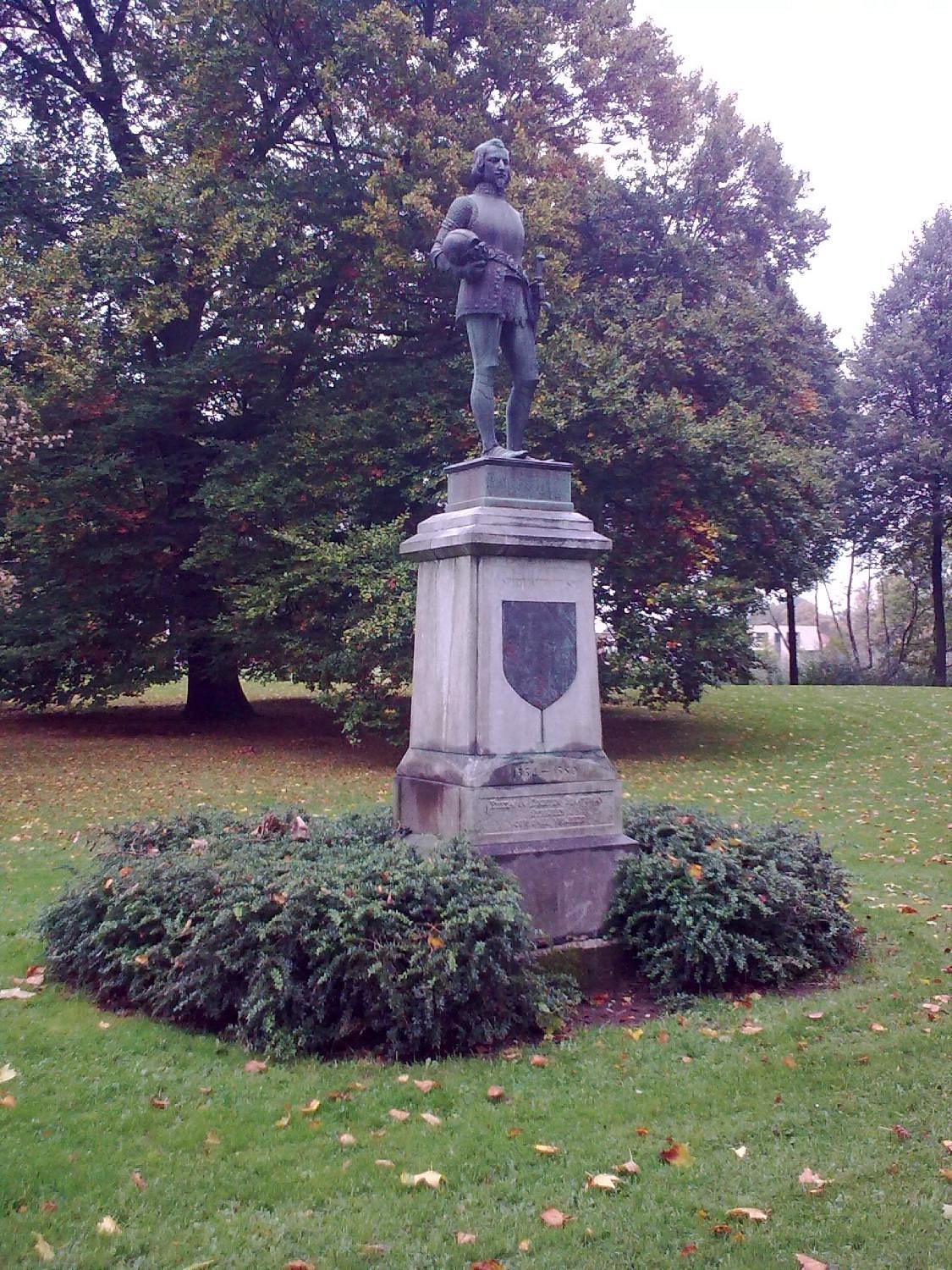
Photo: Zutphen memorial
Frustrated in his hopes of success at the court, Sidney found refuge in poetry. His major prose romance, Arcadia, was written at Wilton for his sister, Mary Herbert, Countess of Pembroke, and broken off – broken off in mid-sentence – when the call came to return to active life in 1585.
According to his school friend and earliest biographer, Fulke Greville, “(Sidney’s) intent and scope was to turn the barren philosophy precepts into pregnant images of life.” With this in mind, the reader of the two versions of the Arcadia can regard it not only as a wacky adventure story but also as the rather formless deposit of Sidney’s intellectual enquiries, fuelled by his voracious reading and his discussions – chiefly abroad – with many of the most learned and brilliant minds of the day. Two themes in particular are energetically anatomised in a variety of narrative guises throughout the Arcadia: the nature of good government; and human love.
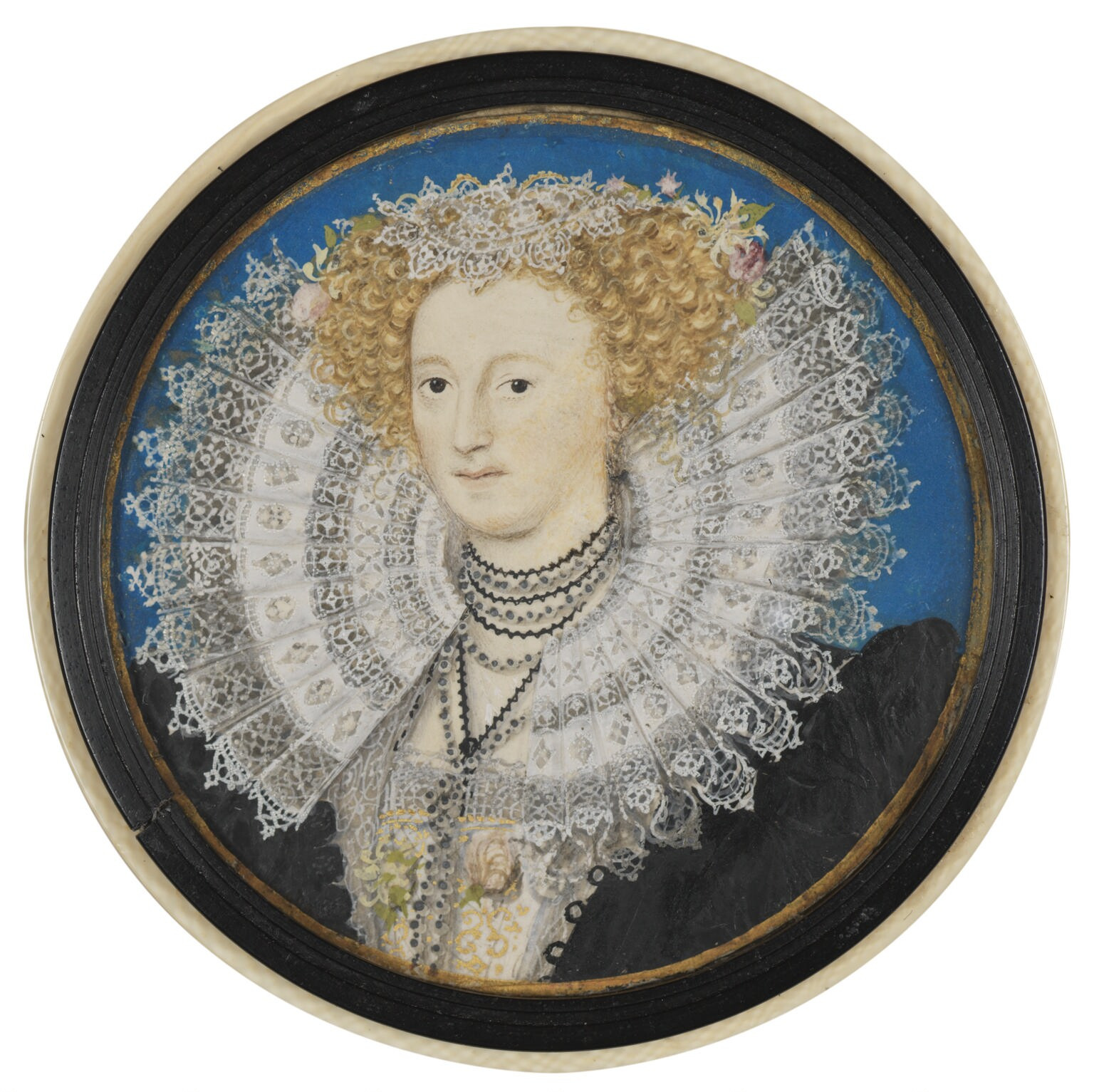
Photo: Mary Sidney
Sidney’s most overtly philosophical work, The Defence of Poesy, was probably written to confute the views of those Puritans who held that poetry at best was an idle waste of a man’s abilities and at worst a danger to the progress of his soul – it was possibly a direct response to Stephen Gosson’s The School of Abuse which appeared in 1579. Still regarded as a classic of literary theory, full of learning and lucid intellectual analysis remarkable for a man in his twenties, the Defence is also just that: a passionate apologia on behalf of the dignity of,
…heavenly Poesy … who with the force of a divine breath … brought forth things far surpassing (Nature’s) doings.
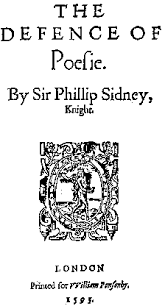
Photo: Defence of Poesy
It is something of a commonplace to regard writing poetry as part of the Renaissance man’s make-up. All over Europe, young noblemen would take off their spurs, pick up a goose-quill and dash off a sonnet before an hour’s exercise at rapier and dagger. But with Sidney poetry must have been something more than that. Had he not been a poet, his career and character would nevertheless have made him the icon of an Elizabethan gentleman; without them his poetry alone would have secured his future fame. Many other courtiers – Sir Walter Raleigh is an obvious example – wrote fine poems, but no-one before Shakespeare composed such a substantial and coherent lyric work as Sidney’s sonnet-sequence, Astrophil & Stella.
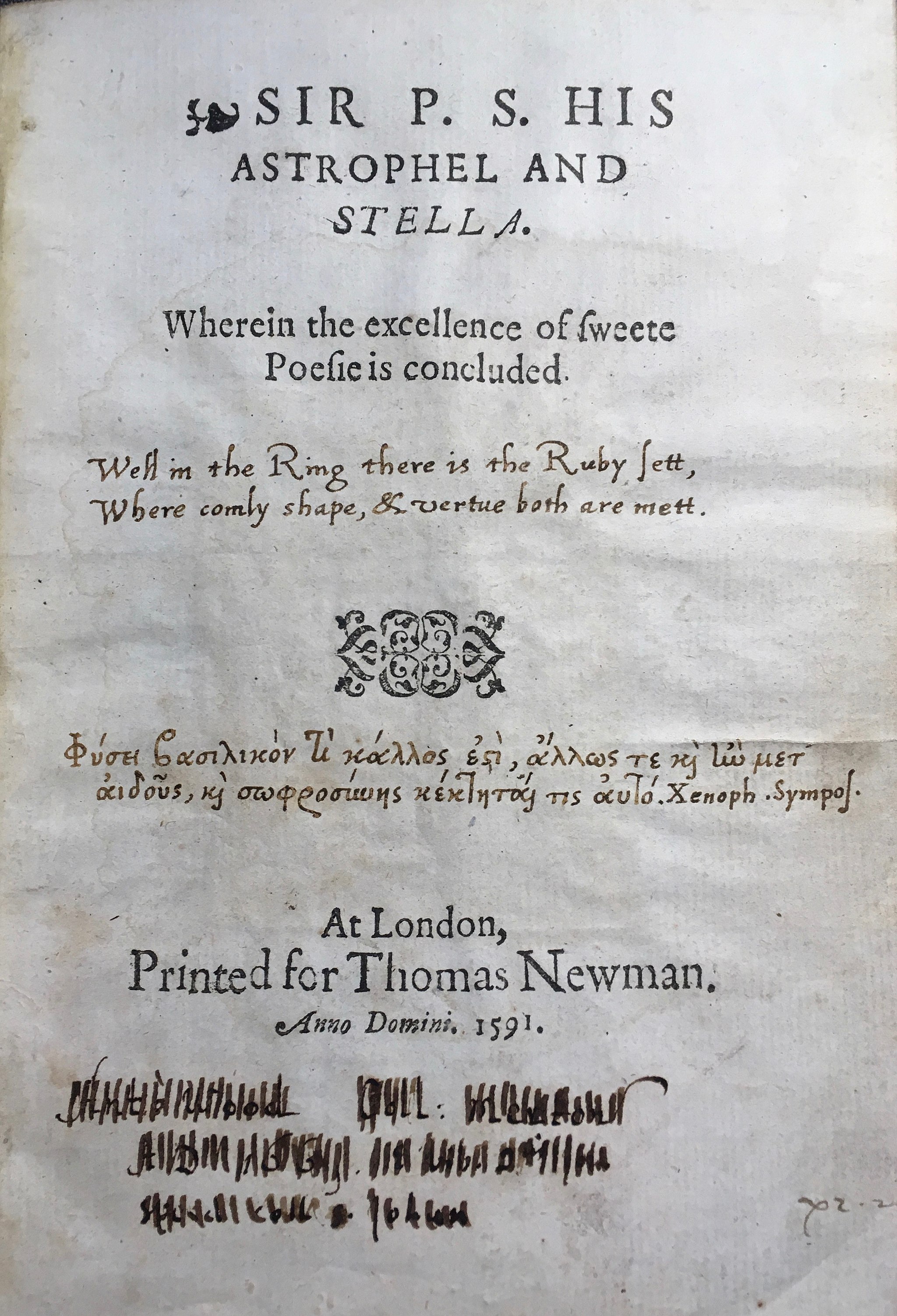
Photo: Astrophil & Stella
When all is said, we must not expect too much of ideals. Or too little. The noble courtier, the chivalrous warrior, the sweet-tongued poet may not be the whole truth. There may well be as much myth in Sidney as man.
But myths are reality, too. The reality of our longings and aspirations. Hamlet knew that man was both the beauty of the world and the paragon of animals, yet also this quintessence of dust, but in our final judgment he is the sweet prince. We cannot escape our human frailties, but we can, in our imaginations and our resolutions, choose the world of Sidney – virtue, grace, constant love, chivalry.
Sir Philip Sidney was buried at St Paul’s Cathedral in London on 16th February 1587, with an elaborate funeral of a type usually reserved for great noblemen. The Universities of Oxford and Cambridge and scholars throughout Europe issued memorial volumes in his honour, while almost every English poet composed verses in his praise.

